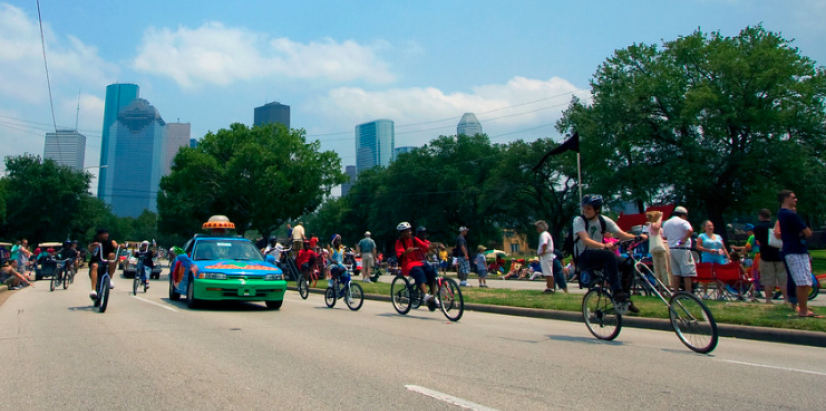Cities have increasingly recognized the importance of local arts communities but the relationship hasn't been without tension. Artists often have to balance their independence with the protocols of public dollars and, particularly when working in neighborhoods vulnerable to gentrification, navigate community-rooted works that support, not extract. A new report from the Kinder Institute, looking at examples from Houston, Denver and San Antonio, argues that cities can do more to engage artists and arts organizations, allowing them to work alongside planners to create more inclusive outcomes for the communities.
"Artists should be more than resources for neighborhood promotion, but rather, key stakeholders in navigating neighborhood change," argues the report, written by former Kinder Institute researcher Grant Patterson with contributions from myself.
Artists can and often play a unique role within cities; engaging in cultural preservation, exploring questions of identity and belonging in the context of community and drawing attention to less visible perspectives. Because of this, artists and arts organizations who work at the community-level are well positioned to engage with cities' planning processes.
Different cities have taken different approaches. Los Angeles, for example, actually embedded an artist within its department of transportation for one year to develop projects that would advance the city's efforts to reduce traffic fatalities. Houston used a one-time grant to create the Resident Artist Program, partnering an artist with an organization or city department in three of its five pilot Complete Communities neighborhoods. Denver's Safe Creative Space Fund works with artists and organizations to bring their spaces up to code.
Equity of access to resources and programs, inclusive planning processes and strategic implementation emerged as common themes across stakeholder interviews and program case studies in Houston, San Antonio and Denver.
Public funding and policy, for example, should be transparent, invest in capacity building opportunities and reach a diverse group of artists and arts organizations. Supporting public art, then, isn't simply about commissioning new work but also about "helping organizations build new partnerships, articulate their missions, train executive leadership, diversify revenue streams and access new communities of learning and data resources."
When it comes to implementation, impact assessments that often drive funding should consider more "qualitative and open-ended measurements of impact," the report argues. "Neither economic development indicators such as jobs creation or completed real estate projects nor arts impact indicators such as attendance and earned revenue fully capture how the work builds social cohesion and empowering residents to articulate their needs and aspirations."
Cities should also look for opportunities to evaluate their own efforts, as was the case in San Antonio's development of the comprehensive plan SA2020. A nonprofit group "took on tracking almost 60 indicators" to gauge the plan's success and the city's arts and culture department "became the point entity" in tracking the success of the arts industries by collecting its own data. "This combined effort has helped the plan's implementation retain momentum," the report notes.
Meanwhile in Houston, the Houston Arts Alliance has used its data on funding and engagement to help push the city-supported organization toward a more equitable distribution of grant opportunities with a redesigned grant process.
With the various recommendations that emerged from the report, the city of Houston might consider new iterations of the Complete Communities as a "testing ground for an artist-planner collaborative approach," that could be adopted in other planning efforts. Though the first round of pilot neighborhoods included two arts-focused initiatives, including the Resident Artist Program, these were not part of the initial planning processes and, in the case of RAP, relied on one-time federal funding.
"In future Complete Communities efforts, or any neighborhood planning effort for that matter, artists rooted in involved neighborhoods should be active participants in the cultural planning piece," the report concludes. And their contributions should not be limited to culture planning, according to the report. "Arts and culture needs to be included with other traditional planning topics such as economic development, housing and transportation."
All cities could benefit from such an approach. "Policy makers and planners interested in equitable neighborhood planning should actively explore ways to harness the unique abilities and positions of artists in the plan- ning process, thinking of them as partners," the report argues. "This is not to say that all artists need to become planners. Rather, artists and creative organizations engaged in place-based social issues can help planners engage neighborhoods, enable residents to share their concerns about ongoing changes and empower them to think outside of the box in envisioning the best possible future."
Editor's note: My husband is an artist in Houston and served as one of the resident artists in Houston's RAP program.

